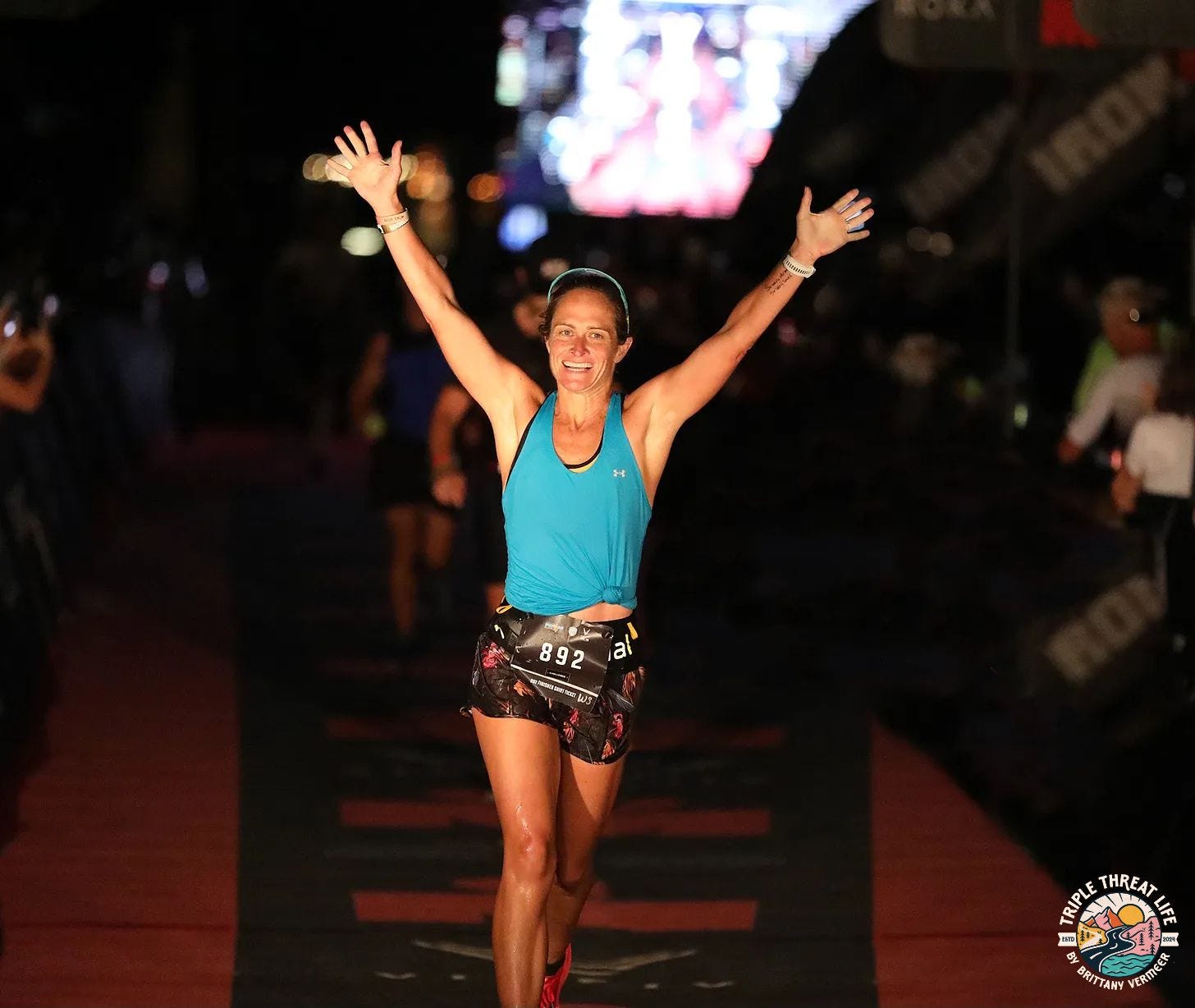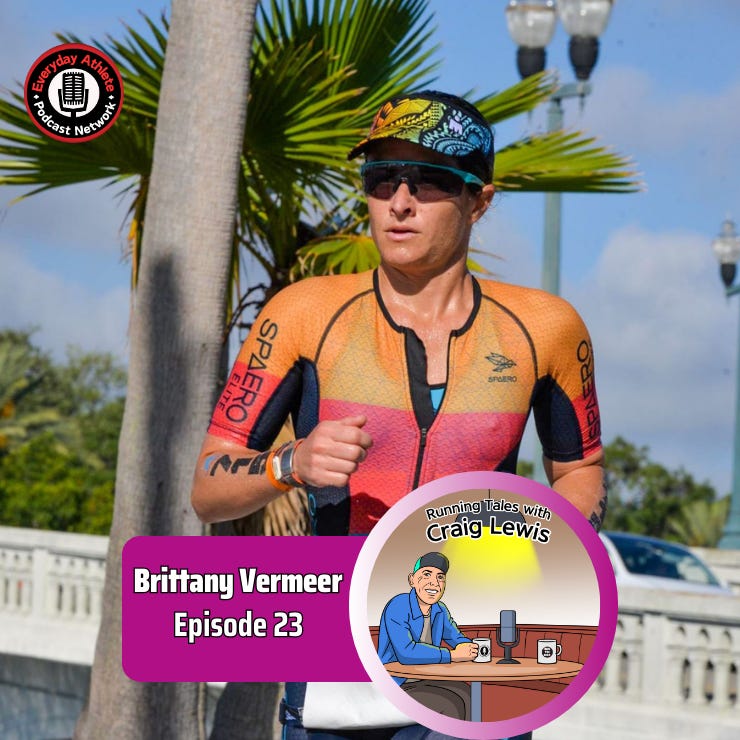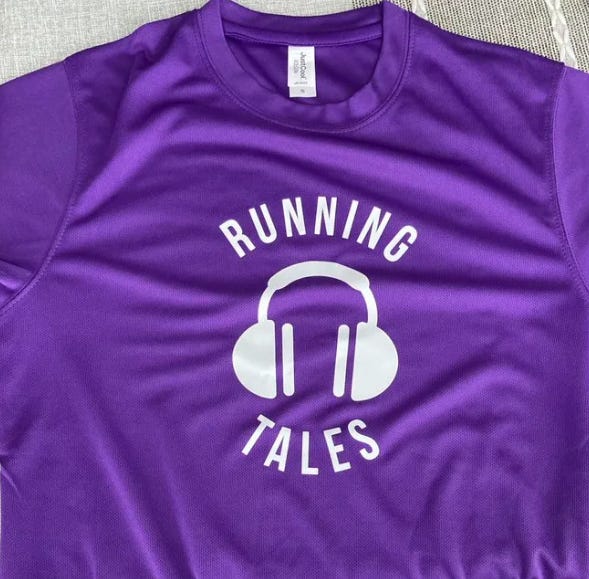Brittany Vermeer: From equestrian world champion to triathlon success
How the 'Triple Threat Life' Substacker found a fresh challenge after switching sports

As a triathlete, Brittany Vermeer has qualified for two and competed at one world championship.
But as someone who was previously more at home on horses, it’s safe to say those appearances weren’t her first ‘rodeo’.
Because before she even dreamed of competing in the swim, bike, run arena, Brittany had been a multiple attendee - and winner - at world championships in the equestrian world.
These days, as well as having competed in the Ironman 70.3 World Championships at St George, Utah in 2021, she has finished seven 70.3 and two Ironman triathlons.
Perhaps her success should be no surprise given her background of a sporty upbringing and the professional mentality she has brought to events from years competing at the top level at equestrian.
But that would doing a disservice to a triathlon journey which, when she started in the sport back n 2019, saw her struggle to run further than between two mailboxes.
From absolute beginner to super sprinter:
Brittany competed in a number of different sports growing up, including football, golf and karate.
But it was showing horses competitively which stuck. In fact, it did so to such an extent that Brittany not only found college success but went on to compete at the elite level.
During 20 years in the sport, she won a total of ten World Championship titles and was the number one ranked rider in America.
When she eventually retired from equestrian, Brittany had to “enter the real world” and discover whatever it was she needed to do next, not only in terms of work but also to keep her competitive fires burning.
“I'd always trained for something,” she said. “I'd trained with a purpose, for a competition, for a goal.
“A friend of mine suggested starting running. And I could not run. When I started I was going from mailbox to mailbox. I was absolutely a beginner.”
Those early runs slowly morphed into short trail runs and 5k’s. Brittany’s friend then invited her to something different: a triathlon club meeting.
She said: “I had no idea what triathlon was, but that's how it got started. My first triathlon was a super sprint - a baby distance.
“I think I was way too prepared for that because I was training with people who had done Ironman. I got a lot of great guidance and it ended up being a great first experience.”
Brittany was hooked, excited by discovering what felt like it could be a sport for life: “You can do it when you're 80 years old. It's a competitive outlet for a lot of people who are not in college anymore.”
How a coach isn’t just for professional athletes:
Right from the start of her triathlon journey, Brittany was determined to approach the sport with a purposeful mindset.
When it came to breaking down the individual elements of triathlon, the life-long Florida resident - who has always spent time in the water - took naturally to swimming.
The bike was similarly enjoyable, but it was running which was her biggest challenge: “I had no background. And throughout my career, up until now, the run is definitely a love-hate kind of thing for me.”
She hired a coach and worked to learn “how you were supposed to do things the right way from the very beginning”.
“That's a part that a lot of people miss because they think, ‘oh, I'm not super fast, I don't need a coach, or I'm not a professional athlete, I don't need a coach’.
“The people who need coaches are the people who have to balance a full-time job with training and kids, and the people who want to reach a goal and aren't exactly sure how to do it.
“It just takes the guesswork out of it because you're given what you need to do and follow a plan.
“There are some coaches that are better than others at that, so you have to figure out what works for you.”
An experienced journalist who has contributed to outlets like Triathlete Magazine, Outside Run, IRONMAN, and XTERRA, Brittany took the time to connect with coaches, experts, and some of the top professional athletes in the world.
“I always have this thing where I have the topic of the article and we're going to talk about it and answer all the questions,” she said. “And then I get to ask you my questions.
“A lot of times that’ll be about a completely different topic. I'm just curious, I like to gather information. I like learning.”
Battling a microburst storm at the 70.3 World Championships:
Brittany said her development in the sport was down to a methodical approach that means she always has to be as prepared as she can be for an event.
“My training group was full of Ironman and Half Ironman athletes,” she said. “A lot of weekends, I ended up doing long rides with them.
“The training I needed to do was more about getting ready to run a half-marathon, because before I did a 70.3, I'd only run one standalone half.”
Brittany said doing the required distances with a group helped her to realise what she was capable of.
“I think that's why the 70.3 is such an approachable distance for people,” she said.
“It does take a commitment to training, but it is not the level a full takes. It’s definitely something that's a little bit easier for people to balance.
“And it's fun because you can be done by 2pm. You’re not out there until midnight.”
Her dedication paid off immediately when she surpassed all her expectations by qualifying for the Ironman 70.3 World Championships at her first attempt at the distance.
“I did my first half Ironman in Chattanooga in 2021,” she said.
“It had been deferred to the next year because of Covid, which was good because I got an extra year to prepare.
“I think getting more experience of racing under your belt was vital.
“I ended up qualifying (for the world championships). It was a surprise. They had put a lot of extra slots in because Chattanooga is a sellout race every year.
“I was maybe 30th in my age group or something like that and I got a roll down slot.
“The worlds would have been my second Half Ironman, so I remember asking my coaches at the time, ‘this is crazy, should I do this?’”
Fortunately, the event - taking place in St George in Utah - wasn’t happening until later in the year, giving Brittany enough time to get more vital training in.
What she hadn’t reckoned for was the onset on race day of a weather phenomenon known as a microburst storm. It saw Brittany tackling high winds, lightning, and even hail during the swim and cycle sections of what was, after all, only her second 70.3 event.
“We had a crazy storm,” she said, “particularly with the hail on the bike. But it ended up being amazing. I was so glad I went there and raced.”
A second world championship qualification was to follow - but was scuppered by an even more important event in her life.
“The second time I qualified, I did not go because I had a choice. My husband and I had another race I wanted to do in North Carolina, a 70.3.
“That was a week before our wedding and then the week after our wedding would have been the World Championships.
“So we decided ‘no, I'll be going on my honeymoon’.”
‘This is horrible… I could do an Ironman’:
Brittany told Running Tales that once she had completed the 70.3 distance, the natural question from the triathlon community around her was as to when would she be doing an Ironman.
“That’s not something I would ever ask somebody because then they feel a little pressure,” she added.
“I've written for IRONMAN, I've written for Triathlete magazine, and let me be clear, if you never do an Ironman you are still a triathlete.
“You can just do sprints, you can just do halves, whatever distance you want. It's very person specific.
“But I think there is this expectation out there from people. They’ll say, ‘you don't know what it's like until you do this’.
“And I think that's not necessary. It just puts pressure on people.
“It's just not part of what I think the whole welcoming environment of triathlon should be.”
As a result, Brittany initially refused to follow the well-trodden route from half to full Ironman, instead concentrating on improving over the 70.3 distance.
She eventually completed six halves before finally deciding to tackle the longer distance.
That decision came during what she calls a “particularly bad” 10k trail run in the heat of Florida.
“I was dying,” she said, “thinking this is really stupid, I hate this. Why am I doing this? And all of a sudden it clicked. I can do an Ironman.
“I thought, ‘this is horrible and it sucks, but I'm doing it so I can do an Ironman’.”
She has since gone up to complete two Ironman events, with one really important lesson standing out from the experience - that the distance is so long it’s possible to make mistakes and still have time to recover.
“A friend told me that it's a long day so if something goes wrong, you fix it,” she said.
“It's not like you're worrying about seconds, you're worrying about sustaining over hours. So, you fix problems and obstacles when they happen.
“And I have had things happen. I got stung on the leg by a wasp while riding. You get weird things that go wrong. People get a flat, they drop a bottle, and you have to learn how to be resilient.
“That mindset part was the biggest thing for me. I don't think a lot of people realise until they get out there and they start doing it that maybe they wish they would have spent a little more time on that, on the mental side of training.”
Thanks to Jason Bahamundi from our partners Run, Tri, Bike for conducting our podcast interview with Brittany Vermeer - catch it on the Everyday Athlete Podcast Network wherever you listen to podcasts
Aside from writing for a host of publications, Brittany has her own Substack blog, Triple Threat Life.
On it, she shares training tips, how-to guides, mindset skills, and expert insights with her readers.
Using her insight, both from her own time in the sport and from talking to those at its pinnacle, Brittany has created an online compendium which is not only essential for those with an interest in triathlon but for anyone involved in endurance sports.
Support Running Tales:
Please help us keep producing Running Tales across Substack and in podcast form:
Also on Running Tales:
Check out our merchandise:
Pretty in Purple: Be a part of the Running Tales revolution with our new merchandise range.
We’ve got buffs, caps, cups, t-shirts and hoodies - why not complete your next run as an everyday runner by doing extraordinary things?











This is so lovely Craig.
It's still weird to read something about myself, as I'm typically the one doing the writing, but it's kind of fun to hear my story put down into words.
I so enjoyed talking with Jason, so thank you both for having me join the podcast!
I idea of regular every day athletes sharing real stories is one that resonates with me.
Thank you!